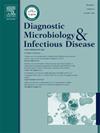Prevalence and genetic insights of linezolid resistance in tuberculosis: A study of sensitive and resistant clinical isolates
IF 2.1
4区 医学
Q3 INFECTIOUS DISEASES
Diagnostic microbiology and infectious disease
Pub Date : 2025-01-29
DOI:10.1016/j.diagmicrobio.2025.116719
引用次数: 0
Abstract
Despite undiagnosed tuberculosis cases, it remains a major global health issue, complicated by antibiotic resistance. Linezolid has been approved for multidrug-resistant (MDR) TB management, but data on its resistance in clinical isolates is limited. This research aims to assess linezolid resistance and identify associated mutations in both sensitive and MDR tuberculosis isolates. The minimum inhibitory concentration (MIC) of linezolid was assessed for 60 isolates, including 40 sensitive and 20 MDR strains, using the broth microdilution method. Additionally, the rplC and rrl genes associated with linezolid resistance was sequenced. Resistance to linezolid was detected in 4 out of the 60 isolates (6.6 %), which included one sensitive strain (2.5 %) and three MDR tuberculosis strains (15 %). The MIC values were found to be 4 µg/ml for sensitive isolates, and 16 µg/ml (n = 1) and 8 µg/ml (n = 2) for the MDR strains. The A297T mutation was detected in one MDR tuberculosis isolate exhibiting linezolid resistance, while no mutations were observed in the rrl gene. Generally, the incidence of linezolid-resistant isolates among tuberculosis cases is 6.6 %, highlighting the necessity of drug susceptibility testing for linezolid in managing complex drug-resistant infections. Further research is required to investigate additional genetic resistance mechanisms in tuberculosis.
求助全文
约1分钟内获得全文
求助全文
来源期刊
CiteScore
5.30
自引率
3.40%
发文量
149
审稿时长
56 days
期刊介绍:
Diagnostic Microbiology and Infectious Disease keeps you informed of the latest developments in clinical microbiology and the diagnosis and treatment of infectious diseases. Packed with rigorously peer-reviewed articles and studies in bacteriology, immunology, immunoserology, infectious diseases, mycology, parasitology, and virology, the journal examines new procedures, unusual cases, controversial issues, and important new literature. Diagnostic Microbiology and Infectious Disease distinguished independent editorial board, consisting of experts from many medical specialties, ensures you extensive and authoritative coverage.

 求助内容:
求助内容: 应助结果提醒方式:
应助结果提醒方式:


